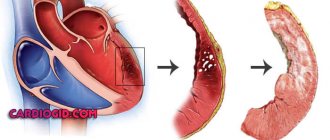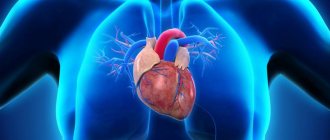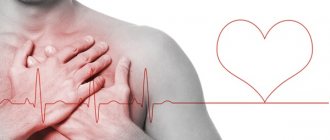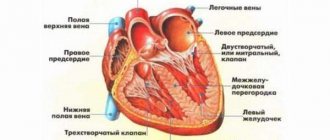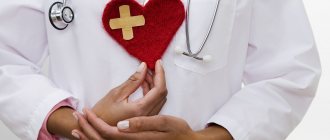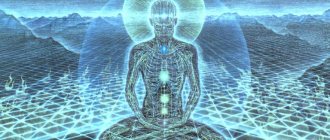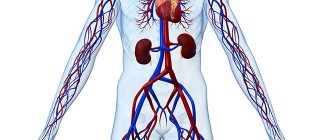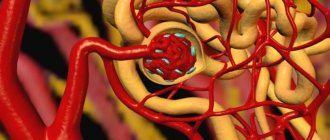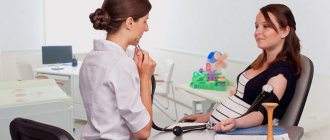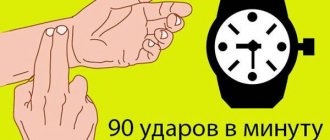When the heart and blood vessels are affected, various diagnoses can be made. Atrial fibrillation is one of the most threatening conditions. It is noteworthy that she appears quite often.
A heart rhythm disorder is a malfunction that develops in parallel with diseases of the heart and blood vessels. That is why diagnosis must be timely and complete. It is this that influences the speed of recovery and the likely occurrence of complications.
Briefly about the pathology
Before we talk about how to cure cardiac arrhythmia, we need to briefly discuss the specifics of this disorder. In general, this term refers to heart disorders that vary in manifestations and mechanisms of occurrence and relate to its rhythm.
Arrhythmias can cause severe disruption of the activity of this muscle and other organs. Often this disorder turns out to be a complication or consequence of serious pathologies.
Symptoms of arrhythmias can be summarized as follows:
- A distinct feeling of heartbeat.
- Weakness.
- Dizziness.
- Interruptions and freezing of the heart.
- Chest pain and pressure.
- Fainting.
- Dyspnea.
If arrhythmia is not treated, the disease will begin to progress. And this is fraught with attacks of angina pectoris, thromboembolism, pulmonary edema, acute heart failure or even death.
What causes cardiac arrhythmia? In general, this pathology can be either a consequence of cardiovascular pathology or an independent phenomenon. That is, the reason lies either in damage to the heart muscle or in other changes in the body: problems with the central nervous system, diseases of the thyroid gland or gastrointestinal tract, electrolyte imbalance, chest trauma, etc.
Tachycardia
Now we can talk about how to cure cardiac arrhythmia. Tachycardia is a type of pathology in which the rhythm exceeds 90 beats per minute.
Treatment involves taking sedatives, the most effective of which are Relanium, Phenobarbital and Diazepam. Doctors often prescribe herbal medications: Novo-Passit, Persen, valerian and motherwort extracts, hawthorn tincture.
It is mandatory to take beta-blockers. They regulate the effects of norepinephrine and adrenaline on the body. Here are the recommended products:
- Bisoprolol (“Bisomor”, “Coronal”, “Concor”).
- Metoprolol (Vasocardin, Logimax, Betaloc).
- Atenolol (“Tenolol” and “Prinorm”).
- Nebivolol (“Binelol” and “Nebilet”).
- Timolol (“Ocumed” and “Arutimol”).
- Propranolol (“Anaprilin”, “Propamin” and “Noloten”).
- Nadolol (“Korgard”).
- Oxprenolol (Trazicor and Koretal).
When talking about how to cure cardiac arrhythmia, it is necessary to make a reservation that for tachycardia, medications based on bisoprolol and propranolol are the most effective.
Bradycardia
This pathology is characterized by a slow heartbeat (less than 60 beats per minute). The following drugs are actively used in its treatment:
- "Isoprenaline." It is recommended to administer intravenously. This is an analogue of "Adrenaline". The drug accelerates the contraction of the heart muscle, increases the tone of the sympathetic nervous system and stimulates the adrenergic receptors of the myocardium. The doctor determines the dosage individually, the frequency of administration is 2-4 times a day.
- "Izadrin." Available in the form of injection solution and tablets. It has an auxiliary effect to the main therapy, since the active substance does not affect the heart rate. It is recommended to take it in the form of tablets, which should be placed under the tongue. 2-3 times a day is enough.
- "Ephedrine hydrochloride." Increases blood pressure by constricting blood vessels. Effective for impaired myocardial conductivity. You should take 1 tablet 2-4 times a day. If a patient is diagnosed with atherosclerotic vascular disease, has problems with the thyroid gland or heart disease of an organic nature, he is prohibited from Ephedrine hydrochloride.
- Orciprenaline sulfate (“Astmopent”). This is an analogue of “Izadrina”. And it is much easier to tolerate, and it does not cause any unwanted side reactions. The only contraindication is atherosclerosis. You need to take the drug 0.5-1 tablet 3-4 times a day.
- Ipratropium bromide. Pharmacy name: “Ipratropium”. It is effective in the fight against sinus bradycardia, since it has no effect on the central nervous system and does not cause lethargy or drowsiness. Usually prescribed 0.5-1 tablet 2-4 times a day.
Why is it important to strictly follow treatment recommendations?
It has long been proven that if the patient strictly follows all the doctor’s recommendations, then one can live with atrial fibrillation for a long time and lead an almost full life.
For each patient, the treatment is chosen by the attending physician strictly individually, since drugs can be expensive and have side effects, and there are also drugs that are not always effective. Treatment is selected strictly individually, since a drug that was ineffective in one patient may show positive results in another patient. Therefore, experts advise patients with atrial fibrillation to trust their attending physician, who will select the optimal therapy for a particular case to maintain normal functioning and proper well-being. Only with complete trust between the patient and the doctor is it possible to overcome atrial fibrillation and live with it for many years with a high quality of life. By constantly taking the necessary medications, the patient over time feels a decrease in anxiety and worry about disturbances in heart rhythms.
Extrasystole
This type of arrhythmia is manifested by extraordinary heart contractions. In this case, therapy involves a gradual transition from weak drugs to strong ones. Treatment begins with taking sedatives, but if they do not help, the patient is prescribed antiarrhythmic drugs.
What to take for cardiac arrhythmia is decided by the doctor, but here are the medications that are usually prescribed:
- Sedatives that prevent excessive stimulation of extrasystole foci. These drugs affect brain signals.
- Magnesium and potassium containing drugs that strengthen the heart muscle. The most effective are “Panangin” and “Asparkam”. If the patient is taking diuretics that wash out electrolytes, then intravenous administration of these medications is prescribed.
- If extrasystole occurs against the background of bradycardia, then drugs are prescribed that contain belladonna (“Atropine” in particular).
- Antiarrhythmic drugs. Bretilium, Moracizine, Amiodarone and Propafenone work best. Prescribed to people with rhythm disturbances in the ventricles of the heart and atria. There are a number of serious contraindications and possible side effects.
- In case of extrasystole as a result of tachycardia, the use of glycosides - medicines from digitalis - is indicated. They are administered in small quantities.
It is worth listing some more drugs that help cope with extrasystole, since we are talking about the symptoms, causes and treatment of cardiac arrhythmia. Metoprolol, Cardanol, Betacardin, Sinopril, Pyramil, Enalapril, Amprilan, Moracizine, Bretilium, Nifedipine, Cinnarizine, Verapamil have proven themselves well. , "Propafenone" and "Amiodarone".
Thrombosis
Due to the fact that fibrillation is observed in attacks, which indicates paroxysms, they are guided by the patient’s feelings, selecting an individual treatment regimen for him. In some cases, paroxysmal arrhythmia can become permanent. The likelihood of complications is also one of the important factors that people pay attention to.
One of the most frightening complications is ischemic stroke. People who have atrial fibrillation are 7 times more susceptible to this complication than patients with a normal heart rhythm. This is likely not only with sudden attacks, but also with their constant reduction.
Patients often believe that rhythm disturbances are a consequence of a stroke, but in fact the opposite is true. It is a stroke that is the first symptom of fibrillation. It’s just that the manifestations of the heart haven’t made themselves felt yet. Parts of the heart contract asynchronously, so congestion in the cardiac chambers is observed. This creates the preconditions for the formation of dense blood clots.
When the muscles contract, blood clots can fly out. They travel through the bloodstream and enter the arteries of the brain. Atherosclerotic lesion provokes blockage of a specific artery. As a result, a diagnosis of cardioembolism is made.
Among all complications, thromboembolism is the most common. Strokes are a consequence of thromboembolism in 91% of cases. Such strokes can be dangerous due to their unpredictable consequences. Along with the bloodstream, the thrombus can move to the peripheral arteries of the upper and lower extremities. This is fraught with ischemic phenomena. If left untreated, gangrene may even develop.
In the surgical department, patients have blood clots removed, but it is not always possible to guess what exactly is happening to the person. Not all experts assume MA in the presence of appropriate symptoms. At the same time, diagnosis is almost never difficult.
It is enough to conduct an electrocardiogram to notice uneven intervals between atrial contractions. These are situations where the ventricular response is disordered. The teeth that a normal rhythm has are also absent. As for the pulse, you should not focus on it, since it does not always indicate the nature of the arrhythmia.
Atrial fibrillation
This is a very dangerous pathology, characterized by chaotic contractions of individual muscle fibers. With atrial fibrillation, the pulse can increase to 400 beats per minute, in rare cases – up to 600.
This type of pathology occurs against the background of other pathologies of the cardiovascular system or as a consequence of insufficient functioning of the thyroid gland. Rarely, this disorder becomes a consequence of pathology of internal organs.
What to take for this type of cardiac arrhythmia? The main goal of therapy is to adjust the heart rate. Otherwise, the risk of systemic bleeding, ischemic stroke and even sudden death increases. Therefore, it is very important to reduce the ventricular rate to 80 beats per minute.
You cannot do without taking the notorious beta-blockers - in this case, Metoprolol and Esmolol are indicated. The use of calcium blockers is also indicated: Diltiazem and Verapamil.
"Cordarone" demonstrates greater effectiveness. But this remedy is only suitable for temporary therapy. If you use it for a long time in treatment, complications may arise with the internal systems of the body. Cordarone is also contraindicated if the patient has an individual intolerance to iodine or a lack of potassium and magnesium.
Digoxin is recommended for long-term therapy - it is indispensable for people who need constant monitoring of ventricular contractions and pulse. It is even approved for use in patients with heart failure. Digoxin not only eliminates arrhythmia, it also increases the ejection fraction, stimulating muscle function.
However, Digoxin is poorly excreted from the body, which is why slow intoxication occurs. Therefore, if a drug is prescribed for long-term therapy, it is necessary to monitor the amount of the active substance in the blood. If the concentration is too high, you will have to switch to symptomatic therapy.
Diagnostics
Atrial fibrillation is diagnosed based on:
- collection and analysis of anamnesis;
- detection of characteristic complaints of the patient himself;
- detection of certain specific changes in standard electrocardiogram recordings.
Electrocardiographic signs of the pathology in question are as follows:
- Multiple f waves are detected, confirming atrial fibrillation (flickering). This type of wave may differ in amplitude, shape and other characteristics;
- the recordings completely lack P waves, which are necessarily detected in normal sinus heart rhythm;
- while the QRS complexes are preserved, a chaotic violation of the RR intervals is observed.
In addition, when performing standard electrocardiography, doctors have the opportunity to determine the patient’s associated cardiac pathology that provokes rhythm disorders. Also, to establish an accurate diagnosis and detect all concomitant pathologies, doctors can use diagnostic techniques such as Holter monitoring, echocardiography, cardiac ultrasound, etc.
An example of paroxysmal atrial fibrillation on an ECG
Heart blocks
This is the name for disruptions in the rhythm of contractions that occur due to problems associated with the passage of nerve impulses through the muscle conduction system. Treatment always depends on the severity of the blockade. Here are the brief principles:
- The second degree of type 2 involves constant stimulation with an external pacemaker. At an early stage, this disease can be stopped, but only if the cause does not lie in heredity. Often this disease develops as a result of drug or medication abuse.
- If the blockage is caused by another heart pathology, the person may have a pacemaker installed.
- The third degree of the disease cannot be treated. Therapy is aimed at relieving symptoms and improving quality of life. The goal of treatment is to prevent cardiac arrest. So a pacemaker is installed in all cases.
Incomplete second- and first-degree blockades are asymptomatic and therefore require only observation and routine examinations. Although first they need to be identified, but they are detected only during an ECG.
The greatest risk to human life is posed by high-degree blockades, as well as rapidly progressing diseases. Because in such cases, impaired blood flow and heart failure are observed.
Surgery to install a pacemaker is always performed urgently. The procedure is performed using Atropine, Adrenaline, Theophylline and Dopamine. Rehabilitation involves the mandatory use of m-anticholinergic blockers, beta-agonists and sympathomimetics.
Possible complications and their causes
The main danger that can occur in the presence of arrhythmia is the occurrence of complications. They are provoked not only by improper treatment, but also by physiological factors, for example, concomitant diseases and abnormalities in the functioning of the atria. The following negative prognosis is most likely to develop:
- The attack will end in death due to disruption of the heart muscle;
- Help will not be provided in a timely manner - you need to understand that seconds count;
- The occurrence of complications - thrombosis, stroke, heart failure. Their risk increases if there is a hereditary predisposition and neglect of doctor’s recommendations.
According to statistics, the presence of heart disease accompanied by atrial fibrillation ends in death 70% more often than when only one cardiac pathology is diagnosed.
Fibrillation significantly increases the risk of stroke, although it does not lead to such severe consequences in all cases. To support the body, patients are prescribed a whole range of blood thinning medications. The tablets protect against complications, so there is no need to worry that the heart may stop at any moment - medicine successfully treats such disorders.
Diet
It is also necessary to briefly talk about the specifics of nutrition for cardiac arrhythmia. The diet should be different from the usual one - the patient must actively consume foods with a high content of calcium, potassium, magnesium, as well as other microelements necessary for the functioning of the heart.
Also, by adjusting your diet, you can extinguish the receptors of the vagus nerve. After all, it is he who blocks or inhibits the function of the sinus node, thereby provoking malfunctions of the cardiac system.
In addition, healthy eating is a way to combat excess weight and improve metabolic processes. These factors are also the main provocateurs of cardiac failure.
How to cure cardiac arrhythmia at home? Full recovery is a purely individual matter, but what every person suffering from this disease definitely needs to do is include the following products in their menu:
- Fruits rich in microelements and vitamins. These are pears, plums, bananas, raspberries, apples, oranges and currants.
- Vegetables: cabbage, tomatoes, pumpkin, cucumbers, potatoes, beans, beets, red peppers.
- Boiled meat (turkey, chicken and rabbit) and lean fish (steamed, preferably).
- Honey.
- Dairy products - yogurt and low-fat cottage cheese.
- Rosemary, as it strengthens blood vessels.
- Broccoli, because it contains many microelements and vitamins (fiber, iron, phosphorus, among others).
- Avocado, because it contains copper and iron in huge quantities, as well as enzymes that stop the development of arrhythmia.
- Grapefruit, because it is considered the most valuable source of glycosides and plant fiber. Eating it regularly helps strengthen the heart muscle and normalize the metabolic process.
- Parsley, because it is an excellent diuretic, indispensable for arrhythmia.
Prohibited foods also need to be listed, since we are talking about how to cure heart arrhythmia. It is always recommended to give up smoked meats, offal, fatty meat, pickled and salted products, fatty fermented milk, semi-finished products, canned food, eggs (only steamed and soft-boiled omelettes are allowed) and spices.
Folk remedies
Much has been said above about the causes, symptoms and treatment of cardiac arrhythmia. Now we should briefly discuss folk remedies, the use of which is aimed at combating this pathology and strengthening the muscle as a whole. Here are some simple recipes:
- Mix 400 grams of walnuts, dried apricots and light raisins. Grind in a blender, add finely chopped lemon (along with the peel), mix with May honey (7 tbsp.). Leave for three hours, put in the refrigerator. Take 1 tbsp. l. in the morning and in the evening.
- Mix squeezed black radish juice with honey in equal proportions. Take 15 ml three times a day before meals.
- Take 100 grams of any berries that are good for the heart (listed earlier) and pour a liter of boiling water. Let it brew for 30 minutes. Then add honey (3 tbsp). Drink during the day instead of tea.
- Brew 2 tsp boiling water with two glasses. calendula and leave in a thermos for an hour. Drink 4 times a day, 100 ml.
- Brew rose hips (2 tablespoons) with a glass of boiling water, then leave for one hour. Then strain. Drink the resulting infusion an hour before breakfast.
- Pour 40 grams of lovage root with cold water (4 cups). Let it brew for one night. In the morning, strain and drink the entire volume during the day.
- Mix chamomile, mint and valerian in equal proportions. Then take 1 tbsp. l. collection and pour a glass of boiling water. Leave in a thermos for at least 3 hours. Then strain. Drink the entire volume before bed, you can add honey.
Of course, these are not all effective folk remedies - only some of the most well-known. They are not primary healing agents and are considered only a therapeutic adjunct to the tablets. How to treat cardiac arrhythmia is determined by the doctor, and you will definitely have to consult with him regarding the advisability of using traditional methods.
Forecast
Is it possible to cure cardiac arrhythmia forever? In fact, the prognosis for disorders of this type is extremely ambiguous. Some arrhythmias do not pose a threat to life and health if they are not associated with organic heart pathology. Others, on the contrary, can lead to ischemic stroke, severe heart failure and other consequences.
Be that as it may, it is impossible to completely cure the disease. But achieving stable remission is real! The main thing is to follow all medical recommendations. The doctor will definitely tell the patient in detail how to deal with cardiac arrhythmia individually, based on the results of the diagnosis he has undergone.
Loads
Discussing how cardiac arrhythmia manifests itself and what is generally necessary to treat this disease, we must say a few words about the lifestyle that every person faced with this pathology should adhere to.
It is necessary to give up fast running, walking, physical overexertion, heavy lifting, and also eliminate from your life all factors that provoke anxiety, anxiety and stress. Any of the listed loads are dangerous for cardiac arrhythmia.
It is recommended to take walks in the fresh air more often, relax by the sea and in the forest, and also perform short sets of exercises when you feel well for the purpose of general strengthening.
Measures to improve prognosis
What to do if you are diagnosed with atrial fibrillation? Life prognosis can be improved if you follow several recommendations:
- Follow all doctor’s prescriptions - if you have been prescribed a large number of medications, then you need to take them all;
- If dangerous symptoms of an attack appear, you should immediately call an ambulance;
- Monitor your blood pressure and record all data in a diary;
- Eat a balanced diet, give up bad habits and foods that can worsen your condition. You will also have to monitor the calorie content of the meals you eat, especially if you are prone to gaining excess weight;
- Eliminate stressful situations, tune in to a positive prognosis; for many patients this factor is one of the main ones;
- Adjust your work and rest schedule, as well as physical activity. Exercising is, of course, good, but it is better to consult a cardiologist;
- Remember that prevention is the key to a long life, so visit your doctor regularly and undergo examinations, especially if you are at risk.
In order for fibrillation to recede and the prognosis to be more positive, you should significantly change your lifestyle. This process will not be easy for most patients, but you must understand that treatment is not just about taking pills, but a comprehensive approach is important.
